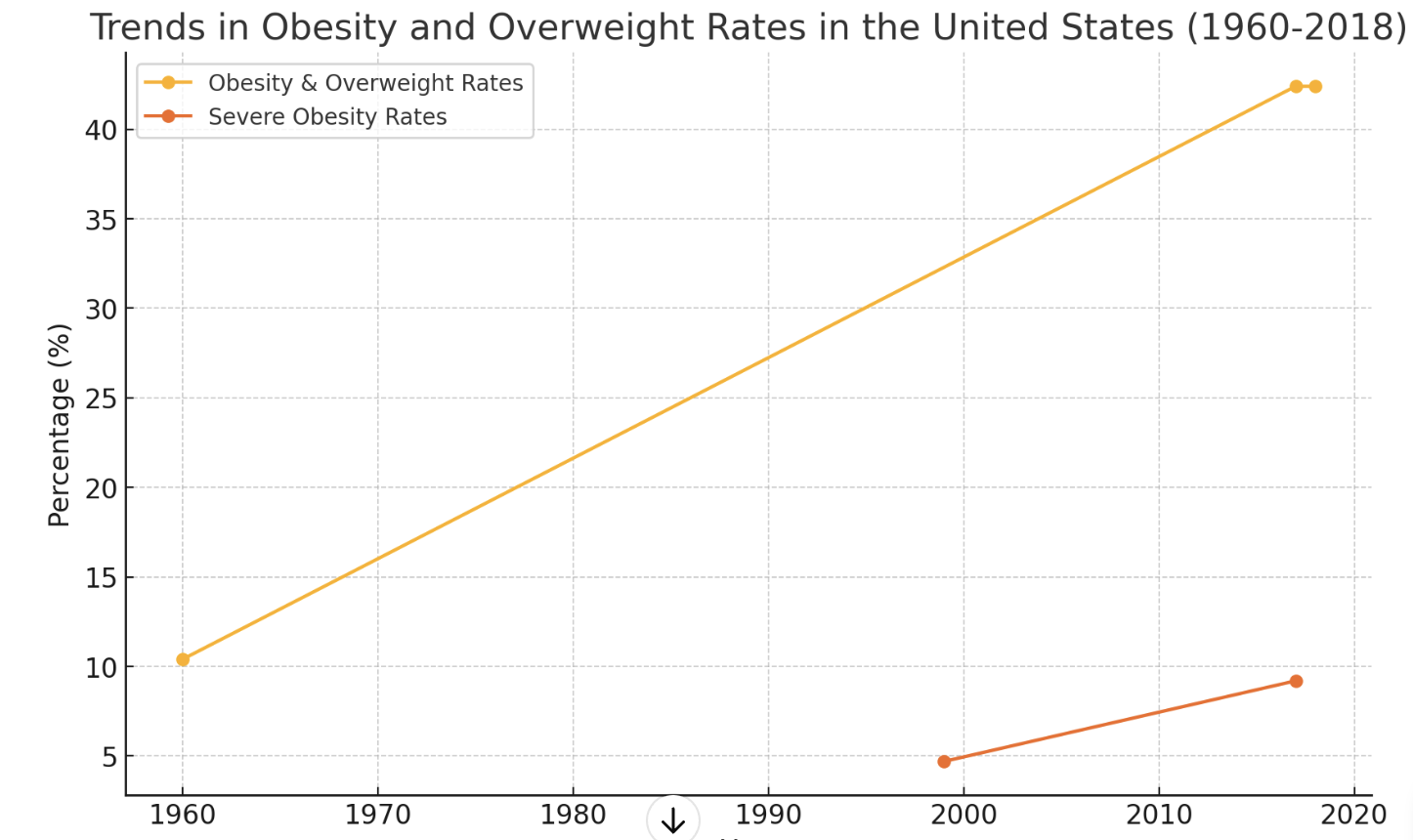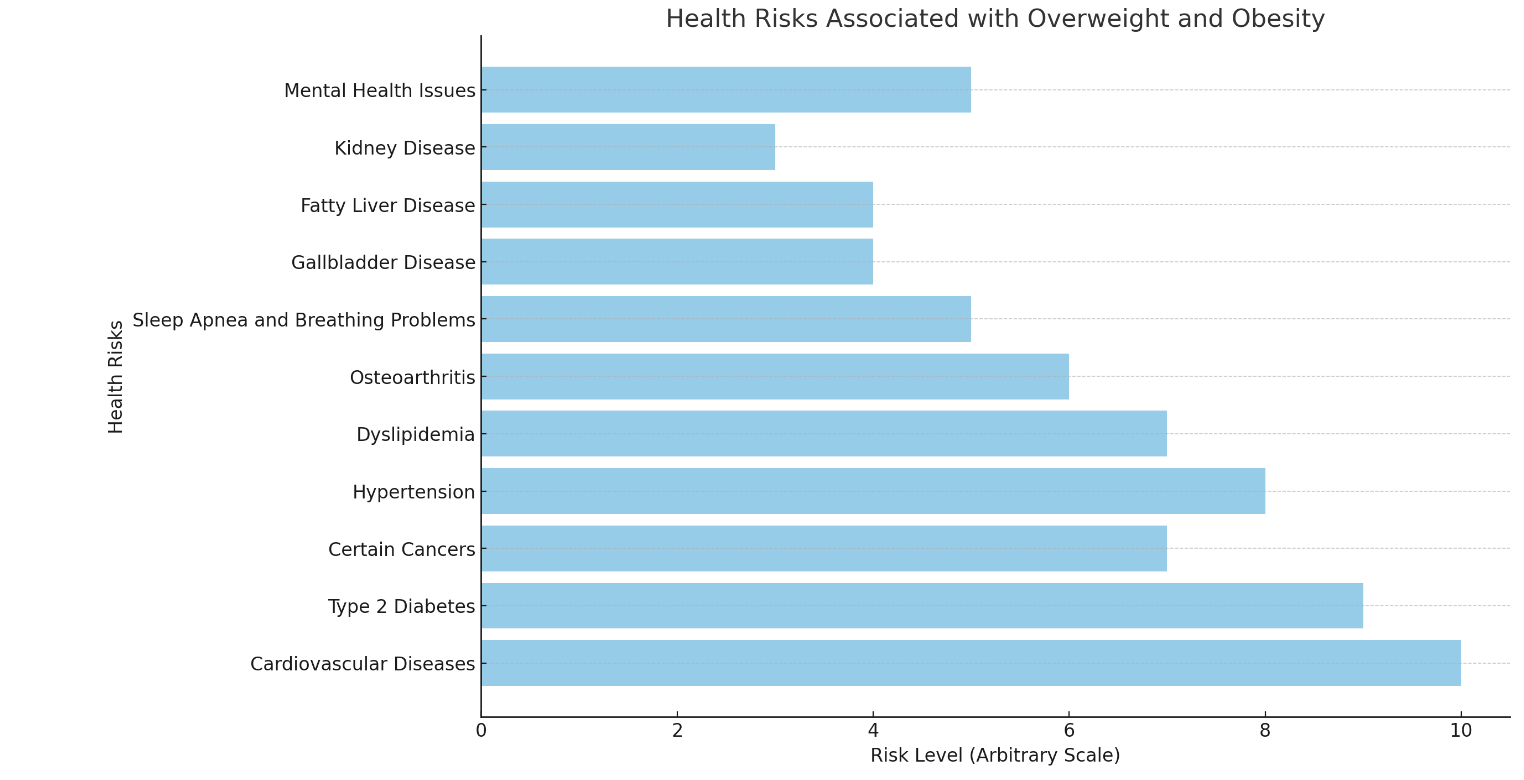Obesity Rates In The World 2023
The high prevalence of obesity rates worldwide has been a longstanding issue due to its related health implications. Like other chronic diseases, the root causes of obesity are diverse, encompassing genetic, sociocultural, psychological, economic, and environmental factors. According to the World Obesity.
Federation (2019), the fundamental reasons for overweight and obesity are as follows:
- Factores genéticos
- Factores metabólicos
- Factores ambientales
- Factores psicológicos
- Factores socioeconómicos
- Hábitos alimentarios
- Actividad física
- Sueño
- Consumo de alcohol
- Medicamentos
Since 1975, worldwide obesity has nearly tripled (World Health Organization, 2017). New findings suggest that obesity rates are on the rise, with over 1.9 billion adults aged 18 years and older being classified as overweight. Among them, more than 650 million are considered obese, constituting 39% of the total overweight population. It is important to note that in most countries, overweight and obesity cause more deaths than underweight. However, it’s crucial to remember that obesity can be prevented and treated.
What are obesity and overweight?
According to the World Health Organization and the National Center for Health Statistics, obesity rates are irregular or excessive fat accumulation that may lead to health problems. Obesity is measured by the body mass index (BMI), which is a simple index commonly used to classify overweight and obesity in adults.
For adults, obesity rates are classified as follows: overweight is a BMI greater than or equal to 25, and obesity is a BMI greater than or equal to 30, according to the World Health Organization.
The body mass index provides the most useful measure of obesity rates as it is the same for both sexes and for all adult ages. However, it should be noted that it is a rough guide and may not correspond to the same degree of fat in different individuals, as it measures excess weight rather than excess fat.
Obesity and overweight not only affect adults
In 2019, research indicated that around 38.2 million children under 5 in several countries were affected by high obesity rates. While overweight and obesity used to be seen as problems mainly in high-income nations, they have been on the rise in low and middle-income countries, especially in urban areas. For example, in Africa, the number of overweight children under 5 has increased by almost 24% since 2000, and in 2019, almost half of the overweight or obese children under 5 lived in Asia.
Obesity and overweight are associated with more deaths globally compared to underweight, given the larger number of obese individuals worldwide. It is a societal responsibility to understand the prevention and treatment of this condition. This article aims to present recent obesity rates to raise awareness about this global issue and emphasize the need for action.
Below, we provide a list of the most obese countries by population in 2017, countries with the highest obesity percentage, and the top countries in terms of obesity prevalence, all based on data from the World Obesity Federation.
The Top Obesity Rates
The Story of Samoa and Tonga: Obesity Rates and Health Challenges
Samoa and Tonga are confronting a pressing health crisis with alarmingly high rates of obesity. In Samoa, 60.8% of men are reported as obese, while Tonga sees an obesity rate of 82.8% among women. These staggering figures underscore the shift from traditional diets to processed foods, sedentary lifestyles, and socio-economic challenges. This epidemic reflects global trends, with the United States leading in absolute numbers. It’s crucial to comprehend the root causes and ramifications of obesity in these nations, emphasizing the urgent need for effective public health strategies worldwide. Join the call to action for comprehensive solutions to combat this critical issue and promote global well-being for generations to come.
| Aspect | Obesity in Samoa | Normal Body Type |
|---|---|---|
| Body Mass Index (BMI) | Typically BMI ≥ 30 | BMI within 18.5 – 24.9 |
| Physical Appearance | Larger body size, excess fat distribution | Balanced muscle, fat, and bone distribution |
| Health Risks | Higher risk of diabetes, cardiovascular diseases | Lower risk of obesity-related health issues |
| Implications | Increased healthcare burden, reduced quality of life | Enhanced physical performance, better overall health |
| Intervention Efforts | Health education, lifestyle changes, healthcare support | Health promotion, active lifestyle encouragement |
According to the World Obesity Federation, research indicates that the United States has seen a significant increase in obesity and overweight rates, rising from 10.4% in 1960 to 42.4% in 2018. In 2017, the prevalence of obesity was 42.4%, showing an increase from 30.5% in previous years. Moreover, severe obesity rates have risen from 4.7% to 9.2%. This data serves as a concerning example of the global trend toward increased obesity.


Check out this bar chart depicting the diverse health hazards linked to overweight and obesity. The horizontal bars signify different health risks, with the length of each bar denoting the relative level of risk (on an arbitrary scale for visualization). This chart underscores the notable health issues connected to overweight and obesity, including cardiovascular diseases, type 2 diabetes, specific cancers, hypertension, and more.
Top 10 countries with the highest Diabetes Rates (2023):
- China – 1,444,216,107
- India – 1,393,409,038
- United States – 332,915,073
- Indonesia – 276,361,783
- Pakistan – 225,199,937
- Brazil – 213,993,437
- Nigeria – 211,400,708
- Bangladesh – 166,303,498
- Russia – 145,912,025
- Mexico – 130,262,216
Obesity and COVID-19
By the beginning of 2021, multiple studies had confirmed a heightened demand for medical services among individuals with obesity who contract COVID-19. A higher body mass index (BMI) has been linked to an increased likelihood of hospitalization, admission to intensive or critical care, and the need for mechanical ventilation. It also raises the risk of mortality from the illness.
Obesity and Diabetes
Type 2 diabetes is significantly impacted by excess weight and obesity. It is estimated that 80-85% of the risk of developing type 2 diabetes is associated with being overweight or obese. Recent research indicates that overweight individuals have a higher likelihood of developing this disease compared to those with a BMI of 22 or lower. Moreover, gaining weight in adulthood also raises the risk of diabetes, even for individuals with a healthy BMI.
Obesity and Cardiovascular Disease
Excess weight is directly connected to heart disease, strokes, and cardiovascular risk factors. As BMI increases, so do blood pressure, cholesterol, triglycerides, blood sugar, and inflammation, which in turn increases the likelihood of experiencing cardiovascular complications such as heart attacks or strokes.
Obesity and Cancer
The text you provided explains the link between obesity and different types of cancer. According to research, there is evidence suggesting that obesity is directly associated with cancers of the esophagus, pancreas, colon and rectum, breast, endometrium, kidney, and gallbladder in both men and women.
Can overweight and obesity be reduced?
The preventability of overweight and obesity, along with their related diseases, underscores the importance of environmental and community efforts to provide accessible, affordable, and healthy food options, as well as opportunities for regular physical activity.
It is essential for individuals to have access to options that enable them to choose a healthier lifestyle. Simple activities that can promote a healthier lifestyle include increasing consumption of balanced foods such as fruits, vegetables, legumes, whole grains, and nuts; limiting intake of fats and sugars; and engaging in daily or regular physical activity.
For individual actions to have their full effect, people need access to a healthy lifestyle. It is crucial to provide support for individuals in adhering to the recommendations above at a societal level. Offering choices such as healthier dietary options and more opportunities for regular physical activity can significantly impact the reduction and prevention of overweight and obesity.
Bariatric Surgery as an alternative for treating obesity
Bariatric or metabolic surgery, commonly referred to as weight loss surgery, is often recommended to treat individuals with obesity. This type of surgery not only results in substantial weight loss but also aids in alleviating many obesity-related conditions. Studies have demonstrated that even a modest reduction in excess body fat lowers the risk of developing diabetes. Additionally, for individuals already diagnosed with diabetes, weight loss can reduce their reliance on medication.
Maintaining a healthy body weight is important for preventing and managing diabetes. While weight loss surgery isn’t a cure for the condition, studies have shown that diabetic patients who undergo bariatric surgery experience improvements in their blood sugar levels. For patients who struggle to control their blood sugar through diet, medication, and exercise alone, weight loss surgery can be extremely beneficial.
Obesity and Overweight Prevalence
By Geographic Region:
| Region | % Obesity | % Overweight |
|---|---|---|
| North | 15.2% | 25.8% |
| South | 19.3% | 32.1% |
| East | 14.8% | 26.4% |
| West | 16.7% | 29.0% |
By Age Group:
| Age Group | % Obesity | % Overweight |
|---|---|---|
| 0-18 | 10.4% | 20.0% |
| 19-35 | 17.3% | 31.5% |
| 36-50 | 24.1% | 37.8% |
| 51+ | 27.5% | 40.2% |
By Gender:
| Gender | % Obesity | % Overweight |
|---|---|---|
| Male | 16.0% | 28.5% |
| Female | 18.5% | 29.8% |
References
- Diabetes Rates By Country 2021. (2021). World Population Review. https://worldpopulationreview.com/country-rankings/diabetes-rates-by-country
- Global Health Observatory. (2019). Global Health Observatory. https://data.worldobesity.org/rankings/
- Obesity and overweight. (2016). World Health Organization. https://www.who.int/news-room/fact-sheets/detail/obesity-and-overweight
- Obesity Prevention Source. (s. f.). Harvard T.H. Chan. https://www.hsph.harvard.edu/obesity-prevention-source/obesity-consequences/health-effects/
- Prevalence of obesity among adults. (2016). World Health Organization. https://www.who.int/data/gho/data/indicators/indicator-details/GHO/prevalence-of-obesity-among-adults-bmi-=-30-(crude-estimate)-(-)
- World Health Organization. (2021, marzo). COVID-19 and Obesity: The 2021 Atlas. https://www.worldobesityday.org/assets/downloads/COVID-19-and-Obesity-The-2021-Atlas.pdf
Feeling stuck?
- Check Your Bariatric Surgery Eligibility Now!
Ready for a Healthier You? Review Your Bariatric Surgery Case Today!
Take the first step towards a healthier, happier you by reviewing your bariatric surgery case. Fill out our quick and easy Surgical Eligibility Form to see if you’re a candidate for life-changing weight loss surgery. Your journey to better health starts here!
Related Post
Learn how to kickstart your weight loss journey












